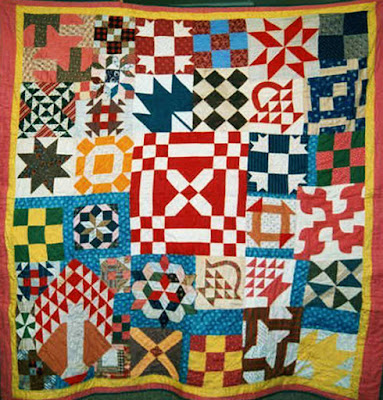Many of us interested in quilt patterns have collections of blocks---lone blocks.
There was a time when we thought these "orphan blocks" needed to be set, quilted and bound.
Wilene Smith addressed this issue thirty years ago in an AQSG Paper. She writes: "Gradually I realized that these were not left over quilt blocks, or stray quilt blocks, but quilt pattern collections."
Her paper "Quilt Blocks? -- or -- Quilt Patterns?" gave us some insight into the origins and use of many of these lone blocks.
Until the explosion of printed patterns in the late 1920s quiltmakers kept pattern blocks just as we keep digital files on Pinterest pages. We can guess their reasons for saving single blocks: Quilts they intend to make; quilts they might make again; patterns to share with friends. And some people just love to collect patterns.
Pattern collector Mary Pemble Barton (1917-2003) collected many vintage single blocks, organizing them by color and tacking them to backgrounds. Her collection is now in the Iowa State Historical Society. Her panels are pictured in the Quilt Index.
Carrie Hackett Hall (1866-1955) was another pattern collector. She donated her collection of over 800 blocks to the Spencer Museum of Art at the University of Kansas. Hall made a few quilts and a lot of blocks in the 1920s and '30s, hoping to make one in every pattern she could find.
California Star
She also collected older blocks which are scattered throughout
the collection.
Block with a note attached from an online auction.
The date may be 1881
When we look at these blocks today we think about women stitching them and perhaps trading them. Here's one origin story that hasn't occurred to me until recently.
1898 Ladies' Art Company catalog
The Ladies' Art Company in St. Louis is well-known as a source of quilt patterns from about 1890 through the 1930s.
For a dime "we will send you...paper patterns" and a colored diagram.
The colored diagram was printed on a small card
But when you notice the fine print in some of the catalogs you also see they would send you a Finished Block.
"We will make up finished blocks to order from any diagram in this catalogue, of any size....It will be impossible to quote any prices here....some...are simple and require little labor, while again others are very complicated....They will be worked in the neatest and most artistic manner....we can make them any size desired."
Has anyone ever identified an "orphan block" as a Ladies Art Company product?
See a post on Emma Zimmer Brockstedt, the woman behind the Ladies Art Company.
http://womensworkquilts.blogspot.com/2018/07/emma-zimmer-brockstedt-and-mail-order.html
See a post on Emma Zimmer Brockstedt, the woman behind the Ladies Art Company.
http://womensworkquilts.blogspot.com/2018/07/emma-zimmer-brockstedt-and-mail-order.html
Double Z - Ladies Art Company 192
Later catalogs listed prices for blocks. Here: 35 cents to 60 cents.
Capital T - Ladies Art Company 84
$1.25 for an appliqued wreath.
I'd buy 9 of the pineapple #93, thank you.
The purchased blocks may be the source of some of these
circa 1900 samplers of different sized squares.
Dated 1905, the Macy Family
from a Laura Fisher ad in The Clarion
And here's another question? Who stitched those blocks in "the neatest and most artistic manner?"
Ladies Art authority Connie Chunn finds the company had 30 employees in the 1930s.






















These are great!
ReplyDeleteDon't you wish you could order quilt blocks through the mail. A new business plan.
DeleteLAC ads for workers. Quoted from an unpublished manuscript (mine):
ReplyDelete"As the business grew, Ladies' Art employed homeworkers in other states in addition to their St. Louis employees. The classifieds in the December 11, 1898, Atlanta (GA) Constitution, the Chicago Tribune, and probably others include this ad: 'Ladies wanting permanent work can earn good pay quietly at home. For full particulars send self-addressed stamped envelope to Ladies' Art Co., B., 221 Pine street, St. Louis, Mo.' Although the wording does not provide clues for the proposed employment of these women, one possibility would be making the quilt blocks that Ladies' Art sold: 'We will make up finished blocks to order from any diagram in this catalogue, of any size, and of any material.'"
I like the word "quietly". Working was such a disgrace. Thanks, Wilene.
DeleteInteresting,,, now to look at one of my sampler quilts and take note of orphan blocks, of which I have many!!!
ReplyDeleteoh YES! I've always wondered about all the orphan blocks I inherited from my grandma. She was a singe mother in the 30's and raised her 2 children by making quilts, baking, ironing and taking in boarders. I inherited ALL of her quilt patterns, quilting templates, bits and bobs of fabric etc. and was amazed at the amount of orphan blocks she had, there were also letters from her customers telling her to use what color for which piece and to add the cost of the fabric to their bill. She had several complicated blocks that had different color swatches pinned to different pieces so she could see what they would look like in the different color ways. I always thought I's put them all together in a sampler but now I think I will leave them as they are.
ReplyDeleteGreat story, Diane. We ought to do a post on your grandma and her business. Write me at materialcult@gmail.com
Deletethank you Barbara Brackman your articles are wonderful I love quilts and making them I have a couple of my Grandma's orphan blocks a house etc
ReplyDeleteI have census records for Joan and Barbara Sellar, sisters from Scotland. They immigrated with their family to USA in 1907. In 1910 the household of ten were living in Chicago. The men were plasterers, and both Joan and Barbara are listed as "quilt makers; working out". They are listed as wage earners with no weeks out of work. Perhaps they were making up blocks at home for a company like Ladies Art. Their future sister-in-law Nellie is one of the block makers in a friendship quilt in my collection.
ReplyDelete